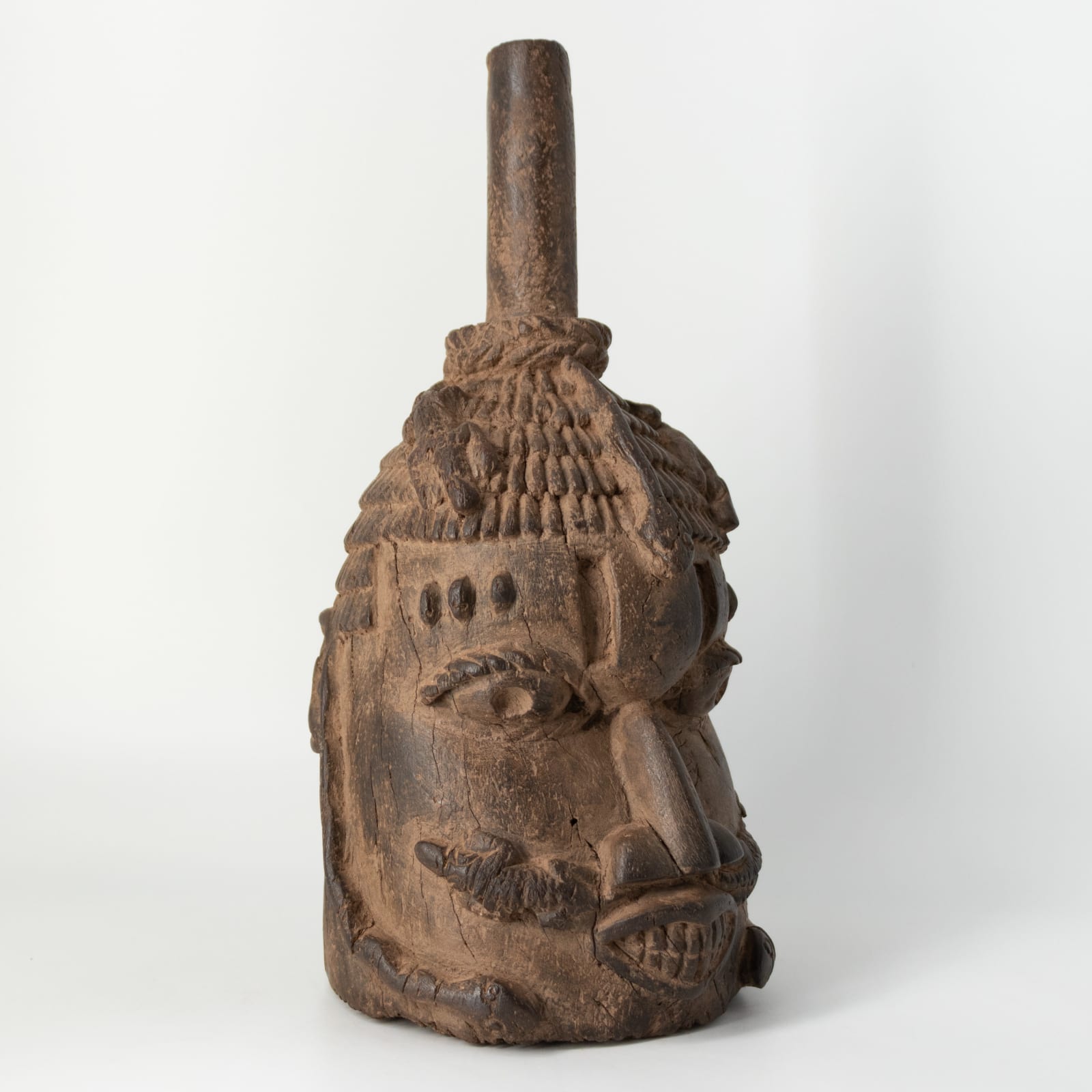Benin Wooden Head of an Oba, early 20th Century CE
Wood
height 40 cm
height 15 3/4 in
height 15 3/4 in
ES.0272.22
Further images
This beautiful head testifies to the artistic refinement of the artisans of Benin during the early 20th century, a period of 'renaissance' in the art of Benin after the British...
This beautiful head testifies to the artistic refinement of the artisans of Benin during the early 20th century, a period of 'renaissance' in the art of Benin after the British punitive expedition of 1897. In the early 20th century, under the reign of the Oba Eweka II the Benin Arts and Crafts School was established, providing a new focal point for the transmission of the cultural heritage of the kingdom to new generations and ensuring the survival of the rich artistic traditions of Benin.
This striking wooden head represents an Oba, one of the hereditary God-Kings of the Benin Empire. It also displays characteristics associated with Iyobas – queen mothers – notably the quadruple pellets over each eye, but the set of the features are undeniably male. The hair is in fact a beaded crown that is cut to the temples across the forehead, then dips once to the level of the ears. It is comprised of five bands of overlapping beadwork in the rear, and three bands at the front. The apex of the head is missing, to allow the introduction of a tusk. The forehead is prominent, acting as a shelf over the eyes, and decorated with a central double scar indentation and four “pellets” arranged in two groups on either side. The eyes are unobscured, large pointed ovals distinct peripheral rims and distinct irises that were originally inlaid with iron.
The kingdom of Benin produced some of the finest artists and craftsmen in the history of the African continent. Yet this heritage was scarcely recognised until the British punitive expedition of 1897, which destroyed and looted the ancient city compounds and in so doing brought the achievements of Benin to the world’s attention. The foundation of the Benin peoples was contemporary with the European late mediaeval period, when the kingdom of Benin was founded by a descendent of an Ife king in c. 1180 CE. In the 15th and 16th centuries the power of the empire stretched across most of West Africa, and those areas not under their control were indirectly influenced by the effect of their trade networks and artistic achievements. Until the late 19th century, the Benin centres were a ruling power in Nigeria, dominating trade routes and amassing enormous wealth as the military and economic leaders of their ancient empire.
Benin art was designed to venerate the achievements and/or memory of the Obas, the divine rulers of the Benin polities. Benin work in bronze and copper, ironworking and sculpting in a range of materials that particularly included ivory was extremely refined and effective; indeed, smelting, forging and cire perdue (lost wax) metalworking methods exceeded any seen in Europe until the 19th century.
This striking wooden head represents an Oba, one of the hereditary God-Kings of the Benin Empire. It also displays characteristics associated with Iyobas – queen mothers – notably the quadruple pellets over each eye, but the set of the features are undeniably male. The hair is in fact a beaded crown that is cut to the temples across the forehead, then dips once to the level of the ears. It is comprised of five bands of overlapping beadwork in the rear, and three bands at the front. The apex of the head is missing, to allow the introduction of a tusk. The forehead is prominent, acting as a shelf over the eyes, and decorated with a central double scar indentation and four “pellets” arranged in two groups on either side. The eyes are unobscured, large pointed ovals distinct peripheral rims and distinct irises that were originally inlaid with iron.
The kingdom of Benin produced some of the finest artists and craftsmen in the history of the African continent. Yet this heritage was scarcely recognised until the British punitive expedition of 1897, which destroyed and looted the ancient city compounds and in so doing brought the achievements of Benin to the world’s attention. The foundation of the Benin peoples was contemporary with the European late mediaeval period, when the kingdom of Benin was founded by a descendent of an Ife king in c. 1180 CE. In the 15th and 16th centuries the power of the empire stretched across most of West Africa, and those areas not under their control were indirectly influenced by the effect of their trade networks and artistic achievements. Until the late 19th century, the Benin centres were a ruling power in Nigeria, dominating trade routes and amassing enormous wealth as the military and economic leaders of their ancient empire.
Benin art was designed to venerate the achievements and/or memory of the Obas, the divine rulers of the Benin polities. Benin work in bronze and copper, ironworking and sculpting in a range of materials that particularly included ivory was extremely refined and effective; indeed, smelting, forging and cire perdue (lost wax) metalworking methods exceeded any seen in Europe until the 19th century.











